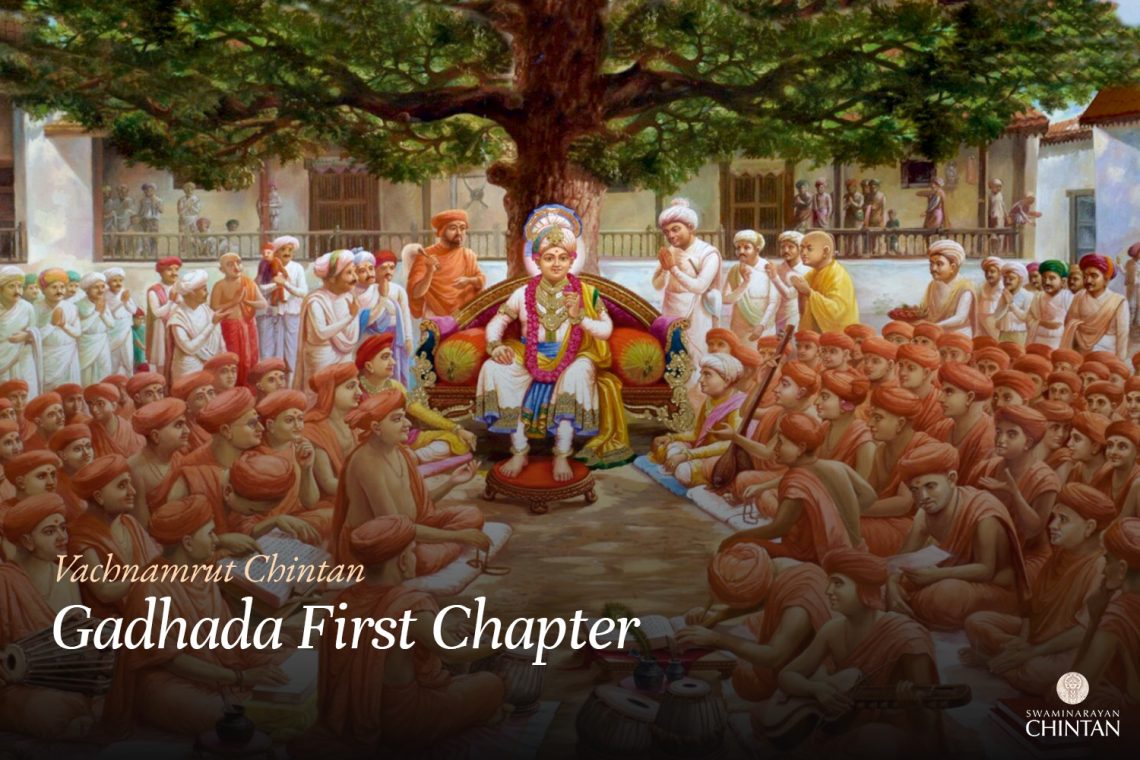Central Insights:
- A devotee should have a sense of discrimination between reality and unreality.
Key Points:
- One should know their own faults and discard them.
- One should know their own form (atman) through saints.
Explanation
This Vachanāmrut discusses discerning between sat and asat (truth and fiction), while Vach.G.F.6 discusses its benefits and weaknesses. The ability to discern between truth and fiction occurs when an understanding of the object is there. This also means understanding when something on the path is wrong as well. This Vachanāmrutam emphasises less on imbibing virtues from someone and more on fostering an understanding of what they are. Shreeji Maharaj says that one should understand their own faults and adopt the virtues of other Satsaṅgi or devotees. This statement does not mean that one should not look at anything else in another devotee – person. Sadguru Nishkulānand Swami says:
Vadne Na Vadvu Vimukh shun, tem sparsharun nahi pandye Kari;
Sarva prakāre samaji papine mukva parhari,
Koi rite kupatrano gun gamijay jo ghatma,
To pār pota pāmtā, tari Bhangyu jāno jai tatmā.
– Vachanvidhi kadvu 17 : 1/2
Shreeji Maharaj has said in Vach.G.M.50 that, a person who thinks that all Sadhus are equal for us, regardless whether they are good or bad – has no sense of discrimination between truth and fiction is Vimukh (atheist) and devotion performed by them are false. Adopting virtues from every place is the central principle for salvation. Similarly. Identifying truth and friction is also a major principle for salvation. Moreover, to adopt virtues in others is not possible without having the ability to identify the distinction between truth and fiction.
Shreeji Maharaj says one should identify one’s own faults. There is little difference between identifying one’s own fault and to accept one’s own fault. When a person is seated in a higher position than oneself, that is when a person sees their own internal deficiencies. However, this simply creates awareness. This does not mean that all our faults are identified by oneself and they would be eradicated. To eradicate deficiencies one has to identify them from its root to fruit. Identify the end results. To identify one’s own fault, requires great effort and an understanding of what the fault is before trying to eliminate it permanently. When one compares themselves to a great saint or devotee, they can see faults informatively, but this does not lead to identification. As there is difference in believing oneself as brahm and being brahmrup both are different. Both are of the same stream but not the same. Likewise, to discard one’s own fault is different than to think about one’s own fault.
Simply evaluating the virtues of another will not allow a person to remove their own faults. For this, a person should self-identify their own faults and try to remove them through personal efforts and when this is not possible that is when the person should seek the company of saints and devotees to help them remove these faults. This requires awareness. Furthermore, the discourse continues by saying that if faults are seen in a saint or devotee, then it is important to eliminate these thoughts and replace them with their virtues. This is because perceiving faults will not aid in personal efforts to eliminate internal faults. Taking this into consideration, a person will benefit from evaluating the virtues of another and when a saint says that “you are Ātman (soul)” we should accept it trustfully and should identify it with the real form of ourself i.e. ātman. Secondly, adopting materialistic pleasures as one’s own should be discarded. And to discard materialistic things or thinking which is cause of bondage and to accept positive thinking which can be useful for discarding materialistic bondage is also called discrimination between sat and asat (truth and fiction). Shreeji Maharaj has mentioned a sense of discrimination between sat and asat as mentioned above.
Glossary
| Asat – Unreality That which is transient and impermanent, leading to bondage. |
| Atman – The Soul The eternal, unchanging self, distinct from the body and material attachments. |
| Brahmrup – State of Spiritual Oneness Realizing oneself as distinct from material existence and aligned with Brahman. |
| Dosh Jnan – Awareness of Faults Recognizing one’s own shortcomings and working towards self-improvement. |
| Gun Grahan – Accepting Virtues The practice of adopting the positive qualities of others. |
| Kupatra – Unworthy Recipient Someone who lacks virtues and is undeserving of spiritual knowledge. |
| Sat – Reality That which is eternal and aligned with divine truth. |
| Satsang – Holy Fellowship Association with saints and devotees that fosters spiritual wisdom and discernment. |
| Vimukh – One who turns away from God & His Devotees A person who distances themselves from devotion and Satsang. |
| Vivek – Discretion The ability to distinguish between right and wrong, leading to wise decisions. |

